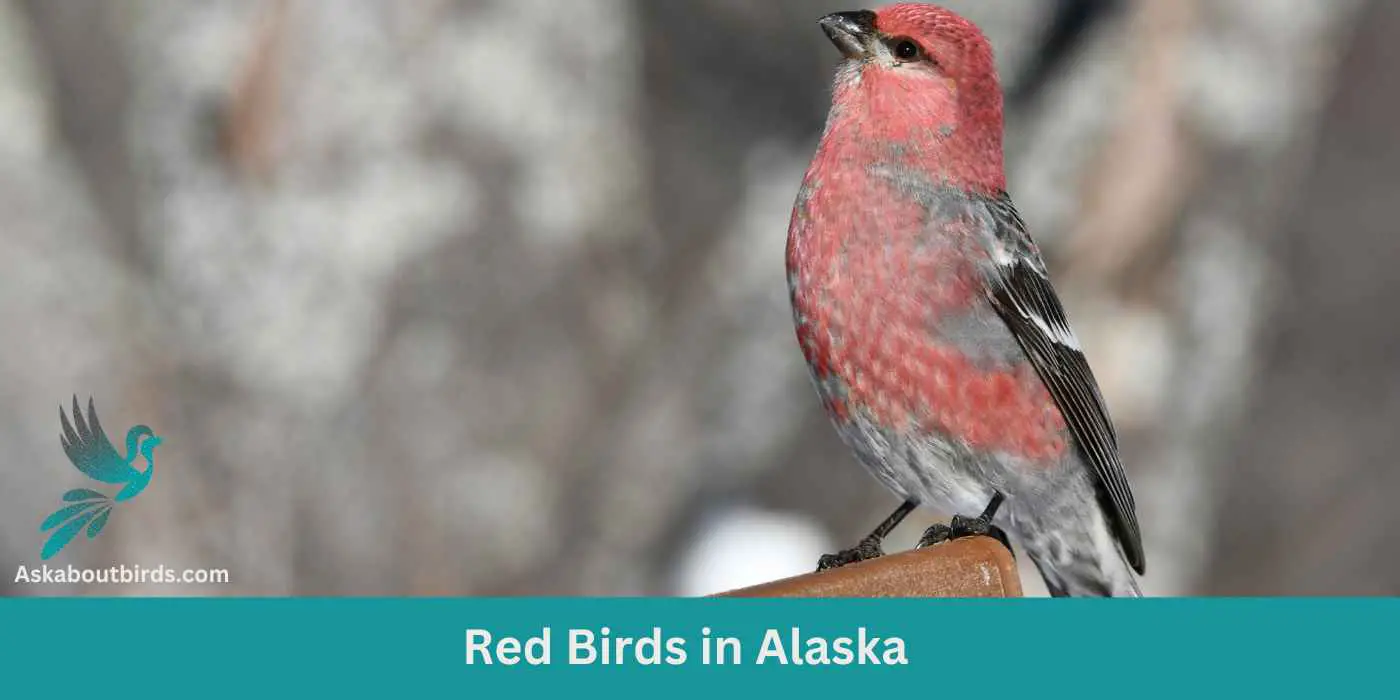Alaska, a vast wilderness with diverse habitats, offers birdwatchers and nature enthusiasts a spectacular array of avian species. It is home to a unique selection of vibrant red birds that provide a striking contrast to its often snowy landscapes.
In this guide, we’ll introduce you to seven magnificent red birds that grace the skies and forests of Alaska.
Red Birds Found In Alaska
Alaska, the northernmost state in the U.S., boasts a vast and varied landscape, from icy tundras to dense forests. This combination of resident and migratory species contributes to the state’s rich avian biodiversity, making Alaska a premier destination for bird enthusiasts.
Northern Flicker

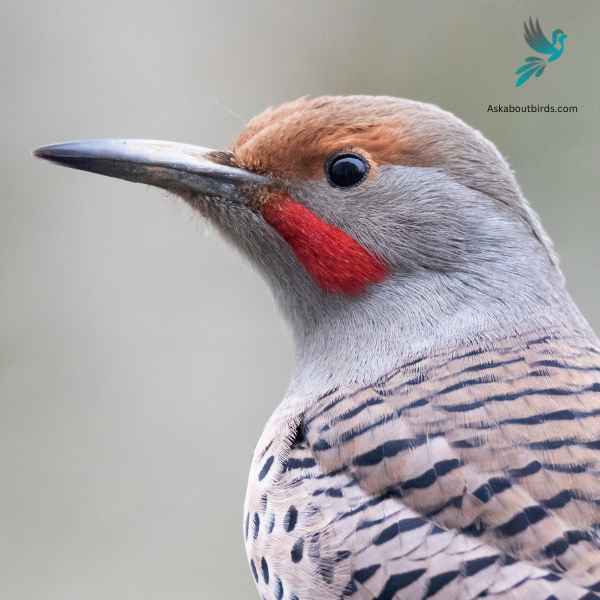
| Feature | Measurement |
|---|---|
| Scientific Name | Colaptes auratus |
| Length | 11–12 in |
| Wingspan | 17–20 in |
| Weight | 3.9–5.6 oz |
The Northern Flicker is a medium-sized woodpecker, recognized by its unique patterns and coloring, often found drumming on trees or foraging on the ground across North America.
Appearance: The Northern Flicker stands out with its grayish brown body, black-scalloped plumage, and a black bib. Males sport a distinctive black or red mustache stripe. Depending on the subspecies, the underwing and undertail feathers can be bright yellow or red, flashing vividly during flight.
Diet: While most woodpeckers are tree-bark foragers, the Northern Flicker prefers hunting on the ground. Its primary diet consists of ants and beetles, supplemented occasionally by fruits, berries, seeds, and other small insects.
Reproduction: Northern Flickers are cavity nesters, preferring to excavate their nesting hole in dead or diseased tree trunks. The interior of the nest is lined with wood chips.
Rufous Hummingbird


| Feature | Measurement |
|---|---|
| Scientific Name | Selasphorus rufus |
| Length | 3.1–3.9 in |
| Wingspan | 4.3 in |
| Weight | 0.1–0.2 oz |
The Rufous Hummingbird is a small, brilliantly colored bird known for its impressive migratory journeys and feisty behavior.
Appearance: The male Rufous Hummingbird boasts a gleaming orange-red body with a white chest and an iridescent red throat, called a gorget. The female has green upperparts with rufous-washed flanks and tail. Her throat may have some iridescent patches, but it’s generally whitish.
Diet: Like other hummingbirds, the Rufous Hummingbird primarily feeds on nectar from a variety of flowering plants. They also eat insects and spiders for protein, catching them in flight or plucking them from vegetation.
Reproduction: Rufous Hummingbirds nest in trees, shrubs, or even ferns. The female alone selects the site, builds the nest, and cares for the offspring.
Red Crossbill

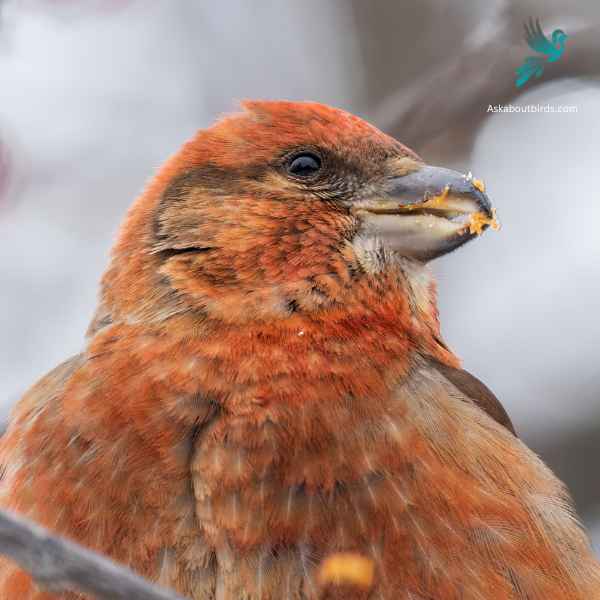
| Feature | Measurement |
|---|---|
| Scientific Name | Loxia curvirostra |
| Length | 5.5–7.5 in |
| Wingspan | 9.8–10.6 in |
| Weight | 0.9–1.4 oz |
The Red Crossbill is a distinctive finch known for its unusual bill, which has evolved to extract seeds from conifer cones.
Appearance: Males are typically bright red or orange, while females are greenish-yellow or olive. Both genders have the characteristic crossed bill, which they use to expertly extract seeds from tightly closed conifer cones.
Diet: Red Crossbills primarily feed on the seeds of coniferous trees, such as spruce, pine, and fir. Their specialized bills allow them to efficiently pry apart conifer cone scales to access the seeds.
Reproduction: Red Crossbills are somewhat nomadic and don’t adhere to a strict breeding schedule. Instead, they breed whenever and wherever food is abundant. Their nests are usually built on horizontal branches of conifer trees.
Common Redpoll


| Scientific Name | Carduelis flammea |
| Length | 5.0 to 5.5 inches |
| Wingspan | 7.5 to 8.7 inches |
| Weight | 0.42 to 0.88 ounces |
The Common Redpoll is a small songbird characterized by its distinctive red cap and streaky brown body. Found primarily in the colder regions, this bird brings a flash of color to wintry landscapes.
Appearance: Males of the species exhibit a pinkish-red wash on their chest, setting them apart from the browner females. Both genders sport a prominent red patch on their forehead, which is the namesake feature, with greyish white and black wings and light underparts streaked with greyish white wings and brown.
Diet: Common Redpolls are granivorous birds, primarily feeding on small seeds. Their favorites include seeds of birches and alders. During winter, they may visit feeders, especially those offering thistle or nyjer seeds.
Reproduction: Nesting usually occurs in shrubs or trees. The female lays a clutch of about 4 to 7 eggs. The nests are cup-shaped and often constructed with twigs, grasses, and lined with feathers.
House Finch


| Feature | Measurement |
|---|---|
| Scientific Name | Haemorhous mexicanus |
| Length | 5–6 in |
| Wingspan | 8–10 in |
| Weight | 0.6–0.9 oz |
The House Finch is a small songbird widely distributed across North America and is commonly found in urban and suburban areas.
Appearance: Males of this species are brightly colored with crimson faces and throats, which can extend to the chest and back, while their flanks have streaks. The female is streaked brown and lacks the red coloring. Both have a square-tipped tail and a distinctively long, flat-topped bill.
Diet: House Finches primarily eat seeds, grains, and berries. They have a particular fondness for sunflower seeds and can be commonly seen at bird feeders. Occasionally, they will also consume insects, especially during the breeding season.
Reproduction: House Finches are cavity-nesters and might choose ledges, vents, ledges, and other urban settings. They might also utilize trees or shrubs. Their nests can be made of a wide array of materials, from feathers to twigs.
Red-breasted Sapsucker
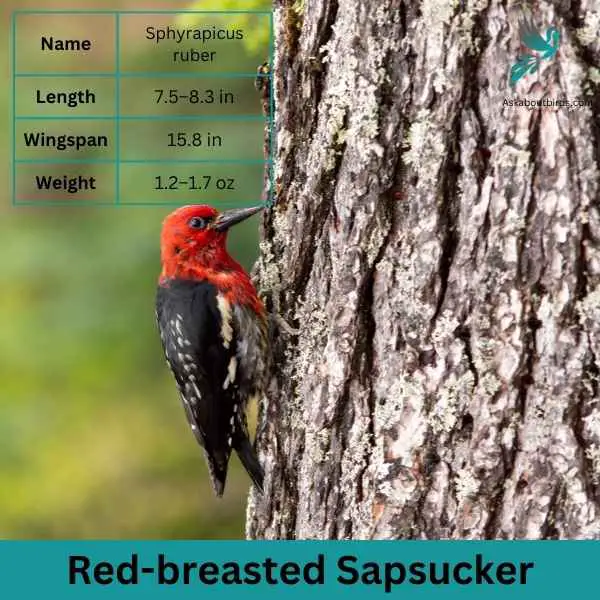
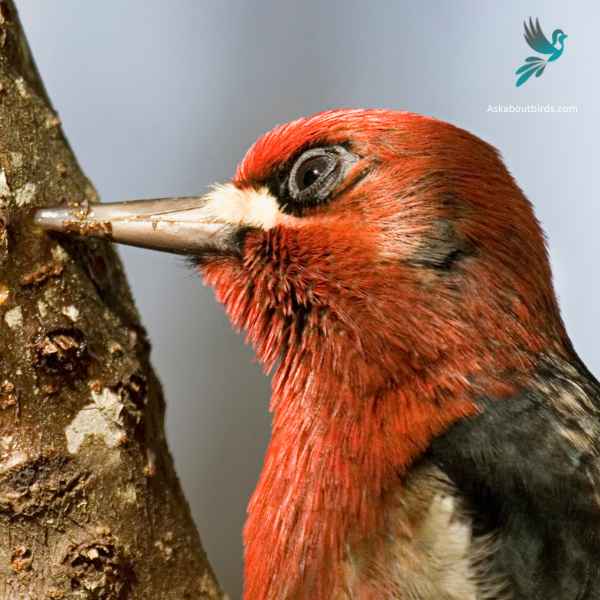
| Feature | Measurement |
|---|---|
| Scientific Name | Sphyrapicus ruber |
| Length | 7.5–8.3 in |
| Wingspan | 15.8 in |
| Weight | 1.2–1.7 oz |
The Red-breasted Sapsucker is a medium-sized woodpecker known for its vibrant coloration and distinctive foraging habits.
Appearance: This bird is primarily recognizable by its bright red head, breast, and flanks. The wings are black with white barring, and there’s a prominent white stripe running vertically down the wing. Its back is barred with black and white.
Diet: True to their name, Red-breasted Sapsuckers drill series of small holes in trees to feed on sap. They also consume insects attracted to this sap, as well as berries and fruits when available.
Reproduction: Red-breasted Sapsuckers create nest cavities in dead or decaying trees, and sometimes in living trees where the heartwood is decayed.
Where to Spot Alaska’s Red Birds
Embarking on a birdwatching adventure in Alaska is a true delight, offering unparalleled opportunities to observe a dazzling array of avian species. Here are the top spots renowned for their bird diversity:
- Kenai Peninsula: Encompassing a mix of forests, wetlands, and coastal areas, the Kenai Peninsula is a hotspot for both migratory and resident birds, including various red birds like the Pine Grosbeak.
- St. Paul Island: Located in the Bering Sea, this remote island attracts a multitude of seabirds, making it a birder’s paradise, especially during migration seasons.
- Denali National Park: This vast wilderness, with its mix of tundra, forests, and high alpine regions, hosts species adapted to its varied ecosystems, including the rare sight of red birds against snow-capped peaks.
- Potter Marsh Bird Sanctuary: Just a short drive from Anchorage, this wetland provides a haven for waterfowl, shorebirds, and other avian species, offering birdwatchers easy access to diverse sightings.
- Wrangell-St. Elias National Park: As the largest U.S. national park, its sheer size and diverse habitats, from coastal regions to mountainous terrains, attract a wide array of bird species, making it a must-visit for any avid birdwatcher.
| Washington’s Red birds | Best Spots for Red Birds |
|---|---|
| Washington | 1. Olympic National Park |
| 2. Nisqually National Wildlife Refuge | |
| 3. Mount Rainier National Park |
FAQs on Red Bird Species Found in Alaska
Which red birds native to northern North America can be sighted in Alaska’s coniferous woods?
In the coniferous woods of Alaska, which is a part of northern North America, bird enthusiasts can spot the White Winged Crossbill. These birds are known for their unique adaptation of crossed bills, which they use adeptly to extract tiny seeds from pine cones. Adult males of this species boast a bright orange to rose pink plumage, making them easily distinguishable from other such birds in Alaska. Additionally, Pine Grosbeaks, characterized by their rose-pink adult males and gray-brown females, can also be observed feeding on the coniferous forests and seeds in the region.
Are there any small red birds in Alaska known for their distinctive tail features?
Yes, the Ruby Crowned Kinglet, a small insectivorous songbird native to western North America, can be spotted in Alaska. While it’s primarily olive-green, males possess a bright, ruby-red crown, which is often raised when they are agitated or displaying. These tiny birds are known for their notched tails and their active nature, frequently flitting about in the forest canopy or hanging upside down on a horizontal branch.
Which birds are commonly seen in South and Central America?
South and Central America are home to a myriad of bird species. Some common birds include the red winged blackbird and the northern cardinal. Birdwatchers might also come across several species common redpoll, birds with specific features such as red winged blackbird with or brown plumage, or common redpoll, birds with a black beak and pale red vest. Additionally, the region is known for small insectivorous songbirds and ruby crowned kinglets.
How can residents of Alaska attract red birds to their backyard feeders?
For Alaskans looking to attract red birds like the Pine Grosbeak and the Purple Finch to their backyard bird feeders, offering black oil sunflower seeds can be quite effective. These seeds are favored by several species within the purple finch’ family. Moreover, providing a mix that includes conifer seeds can be an added incentive for other birds, like the White Winged Crossbill, ensuring a lively and colorful avian presence in Alaskan backyards.

